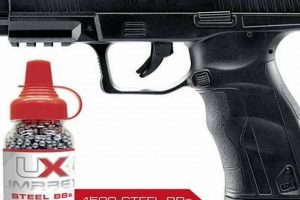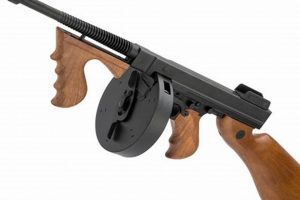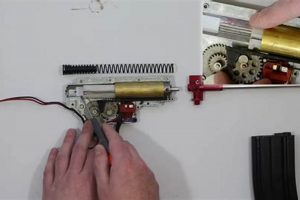The acquisition of an airsoft replica firearm involves several considerations. These considerations include adherence to local laws, age restrictions, and responsible use guidelines. Understanding these factors is paramount before attempting to obtain such a device. For instance, some jurisdictions may require a permit or specific storage conditions.
Owning and using these devices responsibly offers several benefits. It can provide an engaging recreational activity, promote teamwork and strategic thinking, and encourage outdoor exercise. Historically, the replicas have been utilized in training exercises to simulate real-world scenarios, allowing for skill development in a controlled environment.
Subsequent sections will outline the specific legal requirements, age limitations, purchasing options, and safety precautions necessary to become a responsible owner and user of these recreational devices. This information is crucial for ensuring compliance and promoting safe practices.
Essential Considerations for Airsoft Replica Acquisition
This section presents critical information for individuals contemplating the procurement of an airsoft replica firearm. Prior adherence to these guidelines is strongly advised to ensure legal compliance and promote responsible ownership.
Tip 1: Research Local Regulations: Prior to any purchase, thoroughly investigate local and regional regulations regarding the ownership, transportation, and use of airsoft devices. Penalties for non-compliance can include fines and confiscation of the replica.
Tip 2: Verify Age Restrictions: Strict age limitations often apply to the purchase and use of these devices. Ensure the prospective owner meets the minimum age requirement in the relevant jurisdiction. Providing false information regarding age constitutes a legal offense.
Tip 3: Select a Reputable Vendor: Purchase from established and reputable retailers. Such vendors are more likely to provide accurate information regarding legal requirements and safety guidelines. They may also offer warranties or guarantees on the product.
Tip 4: Prioritize Safety Equipment: Always acquire appropriate safety equipment, including eye protection, face masks, and appropriate clothing. Injuries resulting from improper use are preventable with the consistent application of protective gear.
Tip 5: Understand Safe Handling Practices: Familiarize oneself with the safe handling and storage protocols for the chosen device. Negligent handling can lead to accidental injuries or damage to property. Consult manufacturer guidelines and relevant training resources.
Tip 6: Consider Storage Requirements: Some jurisdictions may mandate specific storage protocols, such as locked cases or trigger locks. Compliance with these regulations is essential to prevent unauthorized access and potential misuse.
Tip 7: Review Transportation Guidelines: Understand the proper methods for transporting the replica, particularly if traveling across jurisdictions. Typically, the device should be unloaded, stored in a case, and out of sight during transport.
Adhering to these considerations significantly reduces the risk of legal complications, injuries, and misuse, promoting responsible participation in the airsoft activity.
The subsequent sections will address responsible usage in more detail, including field etiquette and scenario-based training.
1. Legality
Legality constitutes a foundational element in the acquisition of airsoft devices. Understanding and adhering to the relevant laws and regulations is not merely advisable; it is an imperative that dictates whether ownership is permissible. Failure to comply with these legal stipulations can result in severe penalties, including fines, confiscation of property, and potential criminal charges.
- Local Ordinances and Statutes
Jurisdictions vary considerably in their regulation of airsoft devices. Some localities may treat them as toys, while others classify them as replica firearms subject to stringent controls. Researching and comprehending the specific ordinances and statutes applicable to the individual’s location is the primary step. This research should encompass definitions, restrictions, and permissible uses of airsoft devices within that jurisdiction. For example, certain municipalities may prohibit the open carry of airsoft devices in public spaces.
- Federal Laws and Import Regulations
Federal laws may regulate the importation and interstate commerce of airsoft devices. These regulations often pertain to specific markings or features that distinguish the devices from actual firearms. Furthermore, federal regulations may impose restrictions on the use of airsoft devices on federal property. Failure to adhere to federal regulations can result in confiscation of the device and legal repercussions.
- Age Restrictions and Parental Consent
Most jurisdictions impose age restrictions on the purchase and use of airsoft devices. These restrictions are designed to prevent minors from accessing potentially dangerous items without proper supervision. In some cases, parental consent may be required for individuals under a certain age to purchase or possess an airsoft device. Violation of age restrictions can result in penalties for both the minor and the adult who facilitated the purchase.
- Storage and Transportation Laws
Laws pertaining to the safe storage and transportation of airsoft devices are frequently overlooked. Many jurisdictions require airsoft devices to be stored unloaded, in a secure container, and separate from ammunition. Transportation regulations may mandate that the device be transported in a locked case and out of plain view. These regulations aim to prevent unauthorized access and accidental discharge during storage and transit.
The confluence of these legal facets directly impacts an individual’s ability to acquire and utilize an airsoft device responsibly. A comprehensive understanding of these regulations is not optional; it is a prerequisite for lawful ownership and participation in the airsoft community. Ignoring these legal considerations exposes individuals to significant risks and undermines the responsible practice of airsoft activities.
2. Age Verification
Age verification constitutes a critical component in the process of acquiring airsoft devices. Legal and ethical considerations mandate stringent verification processes to prevent access by underage individuals, mitigating potential misuse and ensuring responsible participation in the sport.
- Legal Minimum Age Requirements
Most jurisdictions establish a minimum age for purchasing and possessing airsoft devices. This age typically ranges from 16 to 18 years, depending on local laws. Vendors are legally obligated to verify the buyer’s age through acceptable forms of identification, such as driver’s licenses or government-issued identification cards. Failure to comply with these legal requirements can result in penalties for both the buyer and the seller.
- Vendor Verification Procedures
Reputable vendors employ various methods to verify the age of prospective buyers. These methods may include requiring online purchasers to submit copies of their identification or utilizing third-party age verification services. In-store purchases typically involve a visual inspection of the buyer’s identification card. Rigorous verification procedures are essential to prevent underage individuals from circumventing age restrictions.
- Consequences of Underage Acquisition
Underage acquisition of airsoft devices can have significant legal and social consequences. Minors found in possession of airsoft devices without proper authorization may face fines, confiscation of the device, and potential involvement with law enforcement. Furthermore, irresponsible use of airsoft devices by underage individuals can damage the reputation of the sport and lead to stricter regulations.
- Parental Responsibility and Consent
In some jurisdictions, parental consent may be required for minors to purchase or possess airsoft devices. Parents who provide consent are responsible for ensuring that their children use the devices responsibly and in compliance with all applicable laws and regulations. Education and supervision are crucial to promoting safe and ethical airsoft practices among young participants.
These multifaceted aspects of age verification underscore its pivotal role in the responsible distribution and use of airsoft devices. Robust verification procedures, coupled with parental oversight and education, are essential to safeguarding both the individuals involved and the wider community from potential harm. The importance of these measures cannot be overstated in ensuring the sustainable and ethical practice of airsoft activities.
3. Vendor Reputation
The reputation of a vendor significantly influences the process of acquiring an airsoft replica firearm. A vendor’s standing within the community acts as a crucial indicator of product quality, ethical business practices, and adherence to legal regulations. Selecting a reputable vendor reduces the risk of purchasing substandard or illegal products, ensuring the buyer obtains a functional and legally compliant device.
A well-regarded vendor typically demonstrates transparency in its operations, providing detailed product descriptions, clear warranty information, and accessible customer service. Conversely, vendors with poor reputations may engage in deceptive marketing practices, sell counterfeit or unsafe products, or fail to comply with local laws regarding age verification and sales restrictions. For instance, a reputable vendor will diligently verify the age of buyers and provide guidance on safe handling practices, while a less scrupulous vendor may prioritize profit over responsible sales.
In conclusion, the vendor’s reputation serves as a vital filter in the acquisition process. Prioritizing vendors with established credibility and positive customer feedback minimizes the potential for legal complications, safety hazards, and financial losses. The importance of vendor reputation in the acquisition of airsoft devices cannot be overstated, as it directly impacts the buyer’s experience and overall satisfaction.
4. Safety Gear
The acquisition of requisite safety equipment is inseparable from the responsible procurement of an airsoft device. Possessing the device without appropriate safety measures creates a demonstrable risk of injury. Eye protection, specifically ANSI-rated goggles or masks, is paramount due to the projectiles’ capacity to inflict ocular trauma. The omission of this basic precaution is a direct cause of preventable injuries within the airsoft community. For example, impact from a BB can lead to corneal abrasions or, in severe cases, permanent vision impairment.
Beyond eye protection, comprehensive safety protocols often necessitate the use of face masks, especially in close-quarters engagements. These masks safeguard the mouth, nose, and teeth from potential injury. The absence of a face mask can result in lacerations, dental damage, or even fractures. Furthermore, the consideration of appropriate attire, such as long sleeves and pants, is essential to mitigate the risk of abrasions and contusions from projectile impacts. Investing in these protective measures constitutes an integral component of responsible device ownership.
Ultimately, the correlation between acquiring an airsoft device and procuring appropriate safety gear is not merely a recommendation; it is a fundamental prerequisite for ethical participation in the sport. The failure to prioritize safety not only jeopardizes personal well-being but also contributes to a negative perception of the sport, potentially leading to stricter regulations and limitations. Responsible participation necessitates a commitment to safety at every level, from the initial purchase to ongoing usage.
5. Handling Practices
Proper handling practices are intrinsically linked to the responsible acquisition and use of an airsoft device. Understanding and implementing safe handling procedures mitigates the risk of accidents, injuries, and property damage, fostering a safer environment for both participants and bystanders.
- Safe Storage and Transportation
The safe storage of an airsoft device, when not in use, is paramount to prevent unauthorized access, particularly by minors. Devices should be stored unloaded, with the magazine removed, and in a locked container or secured location. Transportation of the device should adhere to local regulations, typically requiring the device to be unloaded, concealed, and transported in a case. Neglecting these precautions can lead to accidental discharge or misidentification by law enforcement.
- Loading and Unloading Procedures
Safe loading and unloading procedures are essential to prevent accidental discharge. The device should always be pointed in a safe direction, away from people and property, during these processes. Verify the device is clear of obstructions before loading a magazine. Upon completion of use, unload the device by removing the magazine and cycling the action to eject any remaining rounds. Visually inspect the chamber to confirm it is empty. Failure to adhere to these procedures can result in unintended projectiles being fired, leading to injury or damage.
- Safe Firing Techniques
Safe firing techniques include maintaining a firm grip on the device, keeping the finger off the trigger until ready to fire, and only aiming at designated targets within a designated play area. Never point the device at individuals who are not wearing appropriate safety gear or at any object that is not an approved target. Avoid firing over obstacles or blindly around corners. The application of these techniques reduces the risk of accidental injuries and promotes responsible gameplay.
- Maintenance and Inspection
Regular maintenance and inspection of an airsoft device are crucial for ensuring its safe operation. Before each use, inspect the device for any signs of damage, such as cracks, loose screws, or malfunctioning parts. Lubricate the device according to the manufacturer’s recommendations. If any issues are detected, discontinue use and seek repairs from a qualified technician. Neglecting maintenance can lead to device malfunctions, increasing the risk of accidents.
Adherence to these handling practices is not merely a recommendation but a fundamental responsibility for anyone acquiring an airsoft device. Responsible handling promotes safety, prevents accidents, and contributes to the positive image of the airsoft community. Consistent application of these procedures ensures the safe and enjoyable use of airsoft devices.
6. Storage Compliance
The link between secure storage and acquiring an airsoft device is a critical, often legally mandated, consideration. Regulations concerning storage compliance directly impact the process, delineating conditions under which possession is permitted. Failure to adhere to these stipulations can invalidate the acquisition, rendering ownership illicit, even if the initial purchase was conducted lawfully. This connection functions as a gatekeeping mechanism, ensuring responsible ownership from the outset.
Storage compliance takes the form of various legal requirements. Several jurisdictions necessitate that airsoft replicas be stored unloaded, with magazines detached, and within locked containers. This reduces the risk of accidental discharge or unauthorized access, particularly by minors. Real-world scenarios illustrate the significance of such regulations. Instances of children accessing unsecured replicas, leading to unintentional injuries, highlight the tangible consequences of non-compliance. Secure storage practices are, therefore, preventative measures against potential harm, thereby bolstering the integrity of responsible airsoft activity. For instance, storage compliance also plays the vital role, if you have children in your house, buying airsoft is possible but not doing secure storage is illegal.
In summary, adherence to storage compliance is not a mere addendum to the acquisition of an airsoft device, but an intrinsic element. The legality of possessing these devices is contingent upon fulfilling storage requirements. This requirement presents a direct challenge to irresponsible owners, requiring proactive measures to ensure secure storage. This challenge ultimately serves to promote responsible airsoft practices within the wider community.
Frequently Asked Questions
This section addresses common inquiries regarding the responsible and legal acquisition of airsoft devices. The information provided aims to clarify key considerations for prospective owners.
Question 1: Are there age restrictions associated with the purchase of airsoft devices?
Yes, most jurisdictions impose age restrictions on the purchase and possession of airsoft devices. The specific age varies by location but typically falls between 16 and 18 years. Verification of age is generally required at the point of sale.
Question 2: What legal requirements must be met before acquiring an airsoft device?
Legal requirements vary by jurisdiction. These may include restrictions on device appearance (e.g., orange tips), limitations on where the device can be used or transported, and regulations regarding storage and display. Researching local laws is essential.
Question 3: Is it permissible to modify an airsoft device to increase its power or realism?
Modifying an airsoft device to increase its power may violate local laws or regulations. Modifying its appearance to resemble a real firearm more closely can also lead to legal issues. Tampering with the device can void any warranties and may also compromise its safety.
Question 4: What safety precautions are necessary when using an airsoft device?
Appropriate safety gear is paramount. Eye protection (ANSI-rated goggles or masks) is mandatory. Face protection and appropriate clothing are highly recommended. Adhering to safe handling practices and using the device only in designated areas are also crucial.
Question 5: Where are airsoft devices permitted to be used?
Airsoft devices should only be used in designated areas, such as established airsoft fields or private property with the owner’s permission. Public areas are generally prohibited due to safety concerns and the potential for misidentification by law enforcement.
Question 6: What are the potential consequences of using an airsoft device irresponsibly?
Irresponsible use can result in injuries to oneself or others, property damage, legal penalties, and damage to the reputation of the airsoft community. Such actions can also lead to stricter regulations and restrictions on airsoft activities.
In conclusion, responsible acquisition and use of airsoft devices necessitate a thorough understanding of legal requirements, adherence to safety protocols, and ethical conduct. Prioritizing these considerations is essential for ensuring a safe and enjoyable experience.
The next section will provide a detailed guide to different types of airsoft guns and gear.
Conclusion
This discourse has provided a structured examination of how to get an airsoft gun responsibly. The exploration encompassed legal prerequisites, age verification processes, vendor selection considerations, safety equipment necessities, proper handling methodologies, and storage compliance mandates. Adherence to these guidelines ensures lawful acquisition and minimizes potential risks associated with the use of airsoft devices.
The acquisition of an airsoft device should not be regarded as a mere transaction but as the acceptance of a commitment. Responsible ownership demands a dedication to safety, legality, and ethical conduct within the airsoft community. Continuous education and adherence to evolving regulations are crucial for upholding these standards and ensuring the continued viability of the sport.


![Dominate: Best Belt Fed Airsoft Gun Guide [2024] Ultimate Airsoft Guide for Beginners, Tactics & Gear Reviews Dominate: Best Belt Fed Airsoft Gun Guide [2024] | Ultimate Airsoft Guide for Beginners, Tactics & Gear Reviews](https://airsoftica.com/wp-content/uploads/2025/10/th-943-300x200.jpg)




